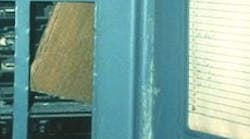How well do you know the Code? Think you can spot violations the original installer either ignored or couldn't identify? Here's your chance to moonlight as an electrical inspector and second-guess someone else's work from the safety of your living room or office. Joe Tedesco, who has a knack for finding shoddy electrical work, did the dirty work and found this mess. Now it's your turn to identify the violation.
Find the Answer
Answer:
For the most part, this circuit directory has been left blank. This violation is all too common and reflects poor workmanship on the part of the installer. Per the first paragraph of 110.22 of the 2005 Code, “Each disconnecting means shall be legibly marked to indicate its purpose unless located and arranged so the purpose is evident. The marking shall be of sufficient durability to withstand the environment involved.”
In addition, 408.4 clearly states the need to identify each individual circuit. “Every circuit and circuit modification shall be legibly identified as to its clear, evident, and specific purpose or use. The identification shall include sufficient detail to allow each circuit to be distinguished from all others. The identification shall be included in a circuit directory that is located on the face or inside of the panel door in the case of a panelboard, and located at each switch on a switchboard.”
And let’s not forget about what is in the picture that shouldn’t be. Yes, that’s a piece of cardboard stuck behind those unused circuit breaker openings. Per 408.7, “Unused openings for circuit breakers and switches shall be closed using identified closures, or other approved means that provide protection substantially equivalent to the wall of the enclosure.” Cardboard is not an approved protection device.



